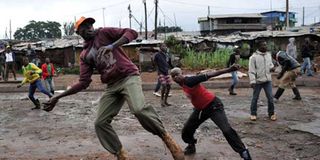Kenya in 2020 is like where it was in 2010, only a bit ‘hotter’

Youths in Kibera, Nairobi, throw stones at police as they opposed the repeat presidential election on October 26, 2017. PHOTO | TONY KARUMBA | AFP
What you need to know:
- The political class has long fully regrouped, and retooled. Many of the minority groups that had moved to the centre have happily retreated to the margins to cash in their devolution cheques.
But there are still a few militia carrying stones, crowbars and machetes, though the primary weapons in use are less crude.
Smartphone keyboards and social media, through which most of the political warriors are unleashing their firepower.
Kenya is in the throes of a bitter battle over the Building Bridges Initiative (BBI), the country’s political equivalent of losing post-partum baby weight and getting back in shape after the 2017 contentious election.
What has made the BBI debate and politics particularly visceral is that it’s the vehicle around which the succession of President Kenyatta, whose second term constitutionally ends in 2022, is now organised.
Critics argue that the push for a referendum on a series of BBI-fronted constitutional reforms is aimed at giving the President and his post-March 2018 ally, Orange Democratic Movement (ODM) leader Raila Odinga, a leg up on his rivals in determining who will be Kenya’s next chief. Suspicion runs deep that the two are trying to stick a knife in the back of Deputy President William Ruto, whom Uhuru had promised the throne.
It’s striking how the events are similar to the political drama exactly 10 years ago but also the differences point to what might happen in 2022.
In mid-February 2010, we were into the second year of the Grand Coalition Government between President Mwai Kibaki and Raila, formed after the deadly post-election violence (PEV) following the December 2007 polls. That was a troubled arranged marriage; the March 9, 2018 ‘handshake’ is an open cohabitation.
That month, on the back of unrest in Raila’s ODM side of the government, he suspended Ruto, who was minister for Agriculture, and his Education colleague, Prof Sam Ongeri, alleging that they were involved in corruption.
In Ruto’s case, it was what notoriously became known as the “maize scandal”.
However, although they were from the opposite side, President Kibaki reversed the suspensions, souring relations in the government further.
This time, too, Ruto is staying put, partly as he became Deputy President on a joint ticket with Uhuru, who cannot easily ‘Raila’ him.
Ten years ago, as today, there was a push for a new constitutional order. The fresh constitution was cooking, and a referendum was eventually held on August 4.
Ruto led the ‘No’ campaign and, in a brief detente, Raila and Kibaki joined cause in the ‘Yes’ campaign, delivering the famous victory in the referendum that ratified the Constitution that the BBI now seeks to tweak by a 68.55 per cent majority.
Although the referendum was five months away, it was still far more civil that the present cut-throat succession in an election that is slightly more than two years away, and a referendum that might not happen soon. If you look at the press from that time, some of the biggest stories that people got worked up over were about road accidents or police shooting: When 11 people died and 30 were injured after a bus and a lorry collided at Ndala, between Maungu and Voi, on February 24; or when the police shot and killed seven taxi drivers in Dagoretti, Nairobi, on March 11. In March, the big stories involved road or air crashes.
In the wake of the PEV, the Kenyan political class had been discredited and disarmed and the country mobilised to abhor the extremist politics and brinkmanship that led to it. A road accident in which 11 people died would horrify still-frayed nerves. Ten years on, we have become inured to them — unless over 50 perish.
And while in 2010 the memories of 2007/2008 madness were still fresh, serving as a check on the worst political instincts, today, they are distant history to many, and some of the youthful hardliners were still children then, so they didn’t “see” it.
There were attempts at forging middle political paths, as evidenced in the creation on February 27 of the short-lived Progressive Democratic Movement coalition by Kalonzo Musyoka, Uhuru and Prof George Saitoti among its most prominent figures. Today, that kind of route doesn’t seem to be available.
Most importantly, however, because the political class and machete wielders had been discredited, they were a little shy and ceded quite a bit of ground.
That ground was occupied by a motley of generally progressive civil society groups (some in alliance with Western donors), intellectuals and the “small tribes” asserting minority rights. These had, historically, been sidelined in Kenya’s politics, which is dominated by the Big Five (ethnic communities), who make over 70 per cent of the population.
The political class has long fully regrouped, and retooled. Many of the minority groups that had moved to the centre have happily retreated to the margins to cash in their devolution cheques — they won, and have put the trophies on their mantles.
But there are still a few militia carrying stones, crowbars and machetes, though the primary weapons in use are less crude — smartphone keyboards and social media, through which most of the political warriors are unleashing their firepower.
You don’t want to sit in the front row on this fight.
Mr Onyango-Obbo is curator of the 'Wall of Great Africans' and publisher of explainer site Roguechiefs.com. @cobbo3





